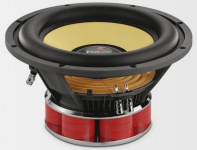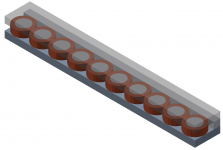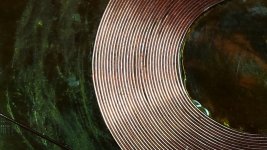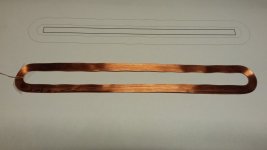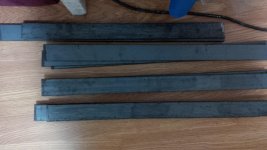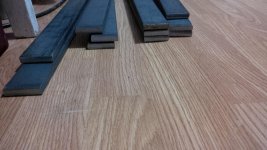Hello there!
I am baking some voice coils for the rubanoid, starting today.
If there are people who are interrested, I'll bake a few more.
Diameters available 0,15 - 0,2 -0,22 mm.
Please give your center tot center distance of your metal strips and the height of your membrane or total height of the magnets and required resistance.
It's for free without warranty.
No shipping costs if it less then €6,00.
BR,
Henjo
Hi Henjo,
I'm in with four pcs of 0.2mm diam, long: 52cm, center to center 1,5cm, 8 ohm impedance, underhung coil. I will give you pm with my adress in three hours from my pc from home.
Thanks
Sergiu
Ps: I made allot of calls today to distribuitors, and i'm waiting again for an price offer for cold rolled steel..
Hi Henjo,
I'm in with four pcs of 0.2mm diam, long: 52cm, center to center 1,5cm, 8 ohm impedance, underhung coil. I will give you pm with my adress in three hours from my pc from home.
Thanks
Sergiu
Ps: I made allot of calls today to distribuitors, and i'm waiting again for an price offer for cold rolled steel..
Hi Sergui,
Isn't your c-to-c distance 20mm?
Thickness of the metal strip + thickness of the magnet.
Is the length/height of the membrane 520mm or the total length of the magnet gap?
Henjo
Hi Henjo,Hi Sergui,
Isn't your c-to-c distance 20mm?
Thickness of the metal strip + thickness of the magnet.
Is the length/height of the membrane 520mm or the total length of the magnet gap?
Henjo
C-to-C is 5mm(c to edge of the mag.) +10mm the magnet+ 5mm (from the edge of the mag.to c). This is for 10 mm steel bars.
The total lenght of the magnets is 520 mm height, and I can go higher with the membrane but the coil must not be bigger than 530 mm (asuming aprox 1mm max space between the magnets).
Thanks
Sergiu
I had started to accumulate my magnets and paper for this type of driver and had some basic designs that look similar to the driver happening here. I may try a couple of different tacks to add to the information gathered here which has been really helpful. Specifically I was going to place two sets of coils on the outside of the two sheets (one coil per sheet).
I'm just about to test some different papers and coil winding techniques, but I can see myself talking to Henjo for a pre-made coil (going for a 50cm long driver) - 3mm wide coil (in 0.2mm copper) to be placed in a 6mm motor face (gap to be determined).
Just using ferrite magnets for this initial test driver. For a next stage I always thought this driver would suit a field coil. Just wind the coil lengthwise on U shape steel, or half pipe. Easier to put together and keeps fingers safe as well as another variable to play with.
One suggestion for a stiffening material in the coil assembly is carbon fibre tissue - I found it at a hobby site - and it is used to stiffen up foam wings on model gliders.
I'll post my findings as they come to hand.
I'm just about to test some different papers and coil winding techniques, but I can see myself talking to Henjo for a pre-made coil (going for a 50cm long driver) - 3mm wide coil (in 0.2mm copper) to be placed in a 6mm motor face (gap to be determined).
Just using ferrite magnets for this initial test driver. For a next stage I always thought this driver would suit a field coil. Just wind the coil lengthwise on U shape steel, or half pipe. Easier to put together and keeps fingers safe as well as another variable to play with.
One suggestion for a stiffening material in the coil assembly is carbon fibre tissue - I found it at a hobby site - and it is used to stiffen up foam wings on model gliders.
I'll post my findings as they come to hand.
Nice idea about the field coil, I thought of it as we'll even looked for commercial flat electro magnets . They are I guess u shaped. Wit the 2 poles next to eachother called patalel pole magnet . What kind of metal shoul I use to do this? I have a winding machine and a small variatie of wires. But winding on a square 50 cm coil might be a problem. Its hard to get tension right to make a nice solid coil. I coul give it a try on a smaller piece of left over cold rolled steel ? Make a bobine that fits it and make a big coil?
But how many turns and how thick wire ? Big power supply with big amperage is easy an cheap nowadays. !!!
But how many turns and how thick wire ? Big power supply with big amperage is easy an cheap nowadays. !!!
Hi Ondesx,
Some progress after sooooooooo many years? 😀
@Wrinex
A better picture.
View attachment 496601
I am happy this thread is still alive.
Henjo
Hi Henjo,
Mee too.😉😀
Cheers
Sergiu
After aprox 20 calls to 20 diffrent steel producers, I managed to place an order of one bar,6meters, of cold laminated steel, a steel, wich is equivallent to AISI1015. Considering my magnets arent N52 I think aisi1015 will not saturate with n42 magnets.
The 6m steel bar is cutted at 55cm long, and has 4cm lenght and 1cm depht.
This monday or tuesday should arrive.
I cant wait to begin the tests. I just need copper wire of 0.18 & 0.2mm awg to begin with.
Cheers
Sergiu
The 6m steel bar is cutted at 55cm long, and has 4cm lenght and 1cm depht.
This monday or tuesday should arrive.
I cant wait to begin the tests. I just need copper wire of 0.18 & 0.2mm awg to begin with.
Cheers
Sergiu
I just need copper wire of 0.18 & 0.2mm awg to begin with.
Cheers
Sergiu
Hi Sergiu,
If I was you, I would use at least Ø 0,2mm.
For 500 mm you have 14 turns of wire.
For Ø 0,224mm 17 turns.
I had my wire here.
Henjo
Hi Ondesx,
Some progress after sooooooooo many years? 😀
I am happy this thread is still alive.
Henjo
Hi Henjo Edel,
Well perhaps a different approach will result in some progress !
The main issues with this driver remain the centering of the coil on one hand and the damping of the whole webs+coil on the other hand.
Indirectly, the second point is very closely related with the density of the material (paper, carbon fiber, plastics, etc.) used for the webs. I still not completely solved all these issues... Unfortunately !
Another consequence of the chosen material is the "form" of these webs... In fact, the constraint used isn't necessarily cylindrical... Depending of the material another constraint has to be implemented !
Anyway, if the measurements improve somewhat, I'll post my personal "vision" of this audio driver !...
Stay tuned...
OndesX
PS : some guys have used "classical drivers" has the "motor" of their Paddock approach here for example !
https://www.youtube.com/watch?v=322VwOQ5Rz4
https://www.youtube.com/watch?v=flXREg8Dxcw
Last edited:
Hi Sergiu,
If I was you, I would use at least Ø 0,2mm.
For 500 mm you have 14 turns of wire.
For Ø 0,224mm 17 turns.
I had my wire here.
Henjo
Hi Henjo,
Thanks for the link.
I'll try at the local shop first.
Cheers
sergiu
So, first coil is baked.
Resistance: app. 7,5 Ohm
Wire Ø: 0,2 mm
Length (straight wire): 180 mm
Turns: 32
Weight: 4,17 gram
Density before baking:
View attachment 496701
Baked:
View attachment 496702
Henjo
Nice. Congratulations. Keep up the good work. 😉
Hi Ondesx,
Thanks for the links, good find.
???
About the centering of the webs.
in which axis do you mean? Looking from the top is it the X or Y-axis?
In my latest model the centering is done by the webs only. The mechanical damping is by the web also. Or did you mean the dampening of the material itself? (frequencies, resonances)
Important is working symmetric and accurately.
The voice coil sandwiched between the webs must be stiff and flat and also have a good connection to the webs. Use a material where the properties will not be influenced by temperature or humidity, or protect against them.
For myself a few points and relationships have to be examined:
Ratio between the length en height of the web. (golden ratio?)
Speed of sound in different materials to find resonances in relationship with the dimensions of the web.
Self damping of the material or….
Make some slots at the end of the web preventing standing waves.
Change the shape of web in a back to back trapezium to prevent standing waves.
Sandwich construction of the web, cancelling standing waves.
Transition frequency from pistonic to bending wave transducer.
If you have some answers or directions do you want to share?
Have you considered molding or deformation of the web material?
There are materials you can shape in form by temperature for example. (PEEK, also used as cone material)
Sandwich/ constraint layer. Bond the two or three different materials in or over a mold to prevent stress.
Best regards,
Henjo
Thanks for the links, good find.
Hi Henjo Edel,
Well perhaps a different approach will result in some progress !
???

The main issues with this driver remain the centering of the coil on one hand and the damping of the whole webs + coil on the other hand.
About the centering of the webs.
in which axis do you mean? Looking from the top is it the X or Y-axis?
In my latest model the centering is done by the webs only. The mechanical damping is by the web also. Or did you mean the dampening of the material itself? (frequencies, resonances)
Important is working symmetric and accurately.
The voice coil sandwiched between the webs must be stiff and flat and also have a good connection to the webs. Use a material where the properties will not be influenced by temperature or humidity, or protect against them.
Indirectly, the second point is very closely related with the density of the material (paper, carbon fiber, plastics, etc.) used for the webs. I still not completely solved all these issues... Unfortunately !
For myself a few points and relationships have to be examined:
Ratio between the length en height of the web. (golden ratio?)
Speed of sound in different materials to find resonances in relationship with the dimensions of the web.
Self damping of the material or….
Make some slots at the end of the web preventing standing waves.
Change the shape of web in a back to back trapezium to prevent standing waves.
Sandwich construction of the web, cancelling standing waves.
Transition frequency from pistonic to bending wave transducer.
If you have some answers or directions do you want to share?
Another consequence of the chosen material is the "form" of these webs... In fact, the constraint used isn't necessarily cylindrical... Depending of the material another constraint has to be implemented.
Have you considered molding or deformation of the web material?
There are materials you can shape in form by temperature for example. (PEEK, also used as cone material)
Sandwich/ constraint layer. Bond the two or three different materials in or over a mold to prevent stress.
Best regards,
Henjo
Last edited:
Henjo,
The centering of the coil (plus the webs of course) in the gap of the magnetic field is paramount !... A lot of distorsion and non-linearities appear otherwise. Please, have a look on the website of Klipple (link provided in one of my last posts).
The webs alone, even symmetrically stretched enough, don't provide a good centering by themselves.
As a consequence of this centering, one introduces a compliance that might be an issue for the motion of the coil !
Not a trivial design for sure.
In the ROWEN driver, the web AND the coils freely move in between the gaps. This is probably one reason of the very good transient response. Though I don't know how they did the centering of the 2 coils (they have twice the problem of "our" driver).
As far as the material used for the webs, I really tested a LOT of things with different densities and different Young's modulus... Notice that most plastics are insensible to humidity, thus this isn't an issue. Each material have his pros and cons... None offers all the qualities for a very good audio driver. Though most have more than 4 octaves !
I think that we lack a good theoretical approach until now.
If somebody have the skills to study the driver on a theoretical point of view, we probably will improve drastically the measurements and obviously the audio quality of this strange driver...
My Best.
OndesX
The centering of the coil (plus the webs of course) in the gap of the magnetic field is paramount !... A lot of distorsion and non-linearities appear otherwise. Please, have a look on the website of Klipple (link provided in one of my last posts).
The webs alone, even symmetrically stretched enough, don't provide a good centering by themselves.
As a consequence of this centering, one introduces a compliance that might be an issue for the motion of the coil !
Not a trivial design for sure.
In the ROWEN driver, the web AND the coils freely move in between the gaps. This is probably one reason of the very good transient response. Though I don't know how they did the centering of the 2 coils (they have twice the problem of "our" driver).
As far as the material used for the webs, I really tested a LOT of things with different densities and different Young's modulus... Notice that most plastics are insensible to humidity, thus this isn't an issue. Each material have his pros and cons... None offers all the qualities for a very good audio driver. Though most have more than 4 octaves !
I think that we lack a good theoretical approach until now.
If somebody have the skills to study the driver on a theoretical point of view, we probably will improve drastically the measurements and obviously the audio quality of this strange driver...
My Best.
OndesX
Last edited:
Henjo,
The centering of the coil (plus the webs of course) in the gap of the magnetic field is paramount !... A lot of distorsion and non-linearities appear otherwise. Please, have a look on the website of Klipple (link provided in one of my last posts).
The webs alone, even symmetrically stretched enough, don't provide a good centering by themselves.
As a consequence of this centering, one introduces a compliance that might be an issue for the motion of the coil !
Not a trivial design for sure.
In the ROWEN driver, the web AND the coils freely move in between the gaps. This is probably one reason of the very good transient response. Though I don't know how they did the centering of the 2 coils (they have twice the problem of "our" driver).
As far as the material used for the webs, I really tested a LOT of things with different densities and different Young's modulus... Notice that most plastics are insensible to humidity, thus this isn't an issue. Each material have his pros and cons... None offers all the qualities for a very good audio driver. Though most have more than 4 octaves !
I think that we miss a good theoretical approach until now.
If somebody have the skills to study the driver on a theoretical point of view, we probably will improve drastically the measurements and obviously the audio quality of this strange driver...
My Best.
OndesX
Thank you for your reply Ondesx,
The non-linearities appear in the Y-axis only, because the magnetic field in the x-axis is linear. Centering the webs in the Y-axis with an elastic material introduces other non-linearities. So, there you have a point.
I'm assembling another iteration of this driver tonight and keep on going in the trail and error mode by lack of knowledge. 😀
Best regards,
Henjo
Hi Henjo,
The coil looks nice but I think it has to much inductance so you loose highs.
I only use a couple of windings for the right balance between to much induction and BL
Build a couple of them all with different voice coils and you can easy measure the difference.
Rob
The coil looks nice but I think it has to much inductance so you loose highs.
I only use a couple of windings for the right balance between to much induction and BL
Build a couple of them all with different voice coils and you can easy measure the difference.
Rob
Hello my friends,
The steel bars had just arrived today, freshly cutted. They have 55cm*4cm*1cm and a total of 10 bars and a little one from a 6 m bar. I found cold rolled steel equivallent for AISI 1015 . 😉
Tomorrow i want to place an order for rice paper and cottone paper, and hope that friday will get the copper wire so that i can began the assembly.
Cant wait.
Cheers
Sergiu
The steel bars had just arrived today, freshly cutted. They have 55cm*4cm*1cm and a total of 10 bars and a little one from a 6 m bar. I found cold rolled steel equivallent for AISI 1015 . 😉
Tomorrow i want to place an order for rice paper and cottone paper, and hope that friday will get the copper wire so that i can began the assembly.
Cant wait.
Cheers
Sergiu
Attachments
- Home
- Loudspeakers
- Planars & Exotics
- A DIY Ribbon Speaker of a different Kind
